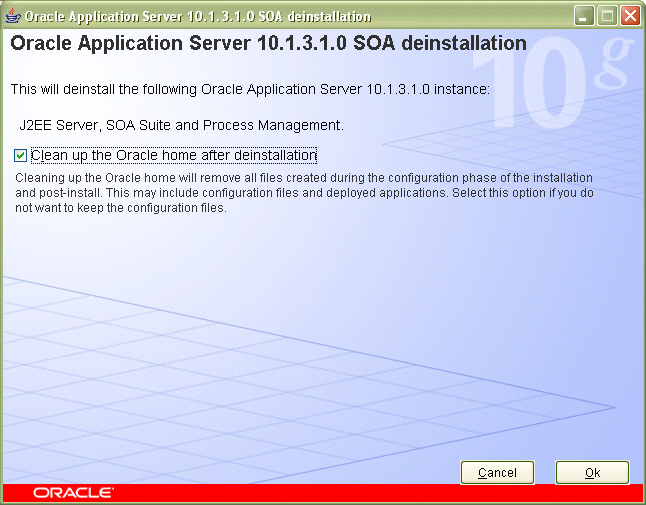
The OUI uses the inventory pointer file to find the inventory location. This script builds the inventory pointer file. The Oracle Universal Installer dialog box appears, prompting you to run the script orainstRoot.sh as root. You accept the default Operating System Group Name, oinstall, and click Next. You have to select an operating system group name with permissions to update, install, and deinstall Oracle products.
#ORACLE 10G UNINSTALLATION SOFTWARE#
When installing software on a Linux or a UNIX system, the OUI also requires the name of the group that owns the base directory. You type oraInventory at the prompt and press Enter to complete the location of the inventory directory. Here you want to specify the location of the inventory directory as /u01/app/oracle/oraInventory. The inventory holds data on every Oracle software product in all Oracle homes on the machine and non-Oracle products included with Oracle software, like the Java Runtime Environment (JRE). Because it contains the bookkeeping for the OUI, you shouldn't delete any files from this directory. The OUI creates the inventory directory automatically to provide subdirectories for each product. In the Specify Inventory directory and credentials page, you must set the location of the inventory directory. To start the software installation, you click Next. On running the OUI installation command, the Welcome page appears. You then change directory to the CD and, from your home directory, execute the command. To do this, you must first log on to Linux as the "oracle" user and mount the Oracle Database 10 g CD.
#ORACLE 10G UNINSTALLATION INSTALL#
Suppose you want to use the OUI to configure the Oracle install environment and create a database. It detects the language setting of the operating system and runs the Oracle installation in the same language. multiple languages The OUI supports multilingual installation.

partial uninstallation You can use the OUI to remove individual components of a database system or you can use it to uninstall the entire database system.

multiple Oracle homes When you use multiple Oracle homes on a single computer, the OUI keeps an inventory of the names, components, and product versions for each of the Oracle homes. This method installs Oracle without any user interaction.Īutomatic dependency detection The OUI automatically detects dependencies between Oracle components and adjusts the installation accordingly. Noninteractive installation You can run the OUI together with a prepared response file that contains installation specifications. Web-based installation The OUI can install Oracle software remotely over HTTP when you point it to a URL.įor example, you can use this feature to install Oracle in an online test environment. In this case, you are installing Oracle Database 10 g on a Linux platform. The Oracle Universal Installer (OUI) enables you to install, upgrade, or uninstall Oracle database components.īecause the OUI uses a Java-based engine, it presents the same interface and installation choices regardless of the platform on which you use it.


 0 kommentar(er)
0 kommentar(er)
